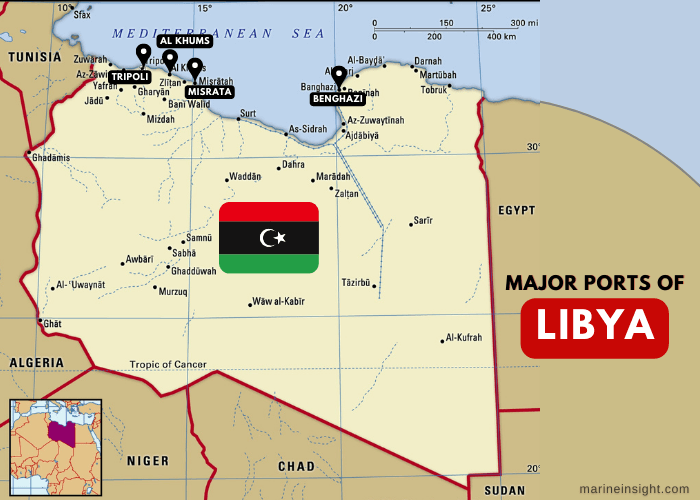5 Major Ports in Libya
The North African nation of Libya is one of the few high-income countries on the African continent. Being the 16th largest in the world in terms of land area with a relatively small population, Libya presents enormous prospects for economic and infrastructural growth. However, progress has been arrested due to continuous factional violence and civil wars that have negatively impacted the economy as well.
A significant portion of the world’s oil reserves is found in Libya, followed by other resources such as natural gas and gypsum. The country is one of the biggest exporters of sweet crude oil in the world, which account for more than 97% of its exports. Apart from petroleum, gold and scrap metal is also exported to European Union, Germany, the US, China, Spain, UAE etc.
It imports most of its food from other countries due to environmental factors coupled with the political turmoil. Wheat, cereals, barley etc are largely imported. Apart from food, capital equipment and consumer goods are other major import items brought from China, Italy, Turkey, Tunisia and Germany.
Libya is bordered by the Mediterranean sea in the north hence the country carries out its international maritime trade and commerce through its numerous ports and oil terminals. However, most commercial ports are in dilapidated condition, lacking proper equipment and modernisation. Protests and blockades, even bomb attacks have halted port operations in the past and significantly impacted the nation’s annual oil production and maritime trade.
The political situation has restricted foreign investments in the nation whose population suffers from a lack of education and unemployment while being dependent on immigrant labour for skilled jobs. Business, service and manufacturing sectors have been impacted and infrastructural development has been restrained due to the war-like situation in the country.
Although the nation earns mainly through its oil revenues, there is a need to diversify the economy and the ports and shipping sector can play a key role in this endeavour. Let us have a look at some of the major ports and oil terminals in Libya.
Port of Tripoli
Lying on the northwestern Mediterranean coast of Libya, Tripoli is the premier port of the country. The city of Tripoli is the country’s capital and is also highly populated. It is Libya’s commercial and manufacturing hub that houses many small industries whose manufactures such as carpets, cigarettes, fish, livestock, chemicals etc are distributed in the region through this port. Heavy industries like gas-bottling units, vehicle assemblage, and oil depots are located close to the port. It lies in the oasis region hence few crops like olives, and some fruits are cultivated nearby. The port’s history goes back to ancient times and it was established by Phoenicians in the 7th century and used by Greeks as an important trading post.
Presently operated and managed by the Ports Authority of Libya, it handles general cargo, bulk and passengers. In 2017, the port was visited by 550 ships and handled 40,000 TEU and 740,000 tonnes of bulk cargo.
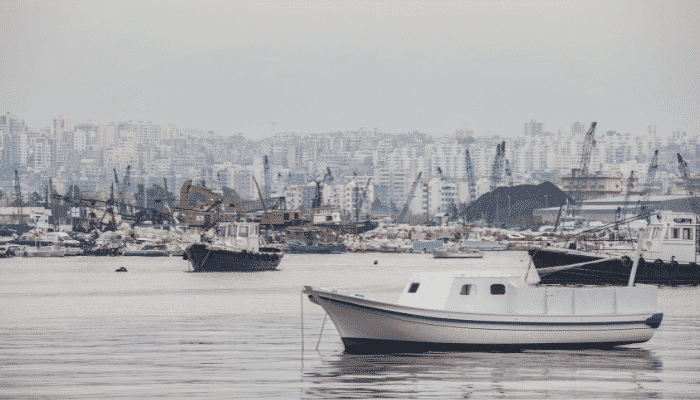
The port harbour spans more than 550 hectares and can handle vessels with a total length of more than 180 m and a draft of 10 m. The port can handle about 4 million tonnes of cargo annually. Tripoli port comprises a general cargo berth covering 40 m and 30 berths for handling containerised cargo with a total length of more than 3000 m.
The port also has 6 berths with storage tanks and sufficient operational equipment such as 3 shore cranes, 11 reach stackers, 14 trailers, 20 forklifts etc.
It also has an enormous storage capacity while offering cold storage facility and 250 reefer points. The port comprises two covered yards spanning 3500 m2 and 9,000 m2 for storing general cargo and 3-grain silos. Another storage yard and warehouse are available for lease to private companies.
Port of Benghazi
Benghazi port is one of the largest Libyan facilities situated on the coast of the Gulf of Sidra, near the Mediterranean Sea in the region of Cyrenaica. The city of Benghazi is the second biggest city in the country and an important centre of administration and commerce. The Benghazi port is a commercial facility housing industrial units like oil refineries, food, salt processing, cement making, breweries, tanneries and fishing. It also houses one of the world’s biggest water desalinization plants, which provides fresh water to most of Libya’s cities. The port is well connected to major cities by roadways.
The Port company of Libya is responsible for port management and operations. Benghazi port suffered due to political reasons and was blocked after 2013, resuming port operations in 2018. The port’s infrastructure deteriorated during this period however it is still operational.
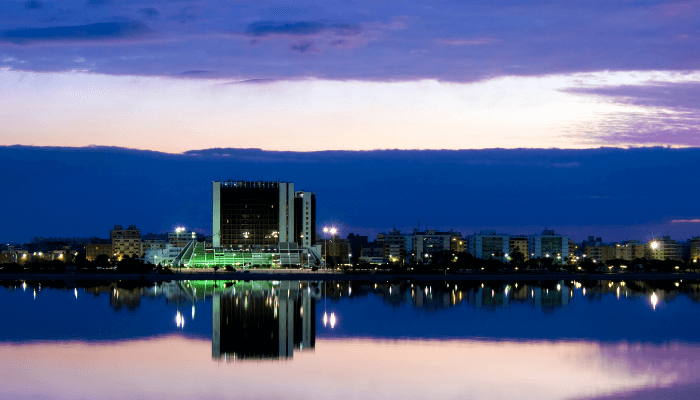
Spanning more than 450,000 sq m, Benghazi port deals with conventional cargo, bulk and containers. Major exports include oil, wool, livestock, rugs while major imports include food, textiles, chemicals, and pottery. Apart from commercial maritime traffic, Benghazi port also handles humanitarian cargoes such as medicines etc destined for other war-torn African nations like Darfur and Chad. In 2018, about 350 ships visited this port and it handled 16000 TEU and 199,000 million tonnes of cargo.
The port is divided into the old port and the Juliana port. The former comprises 9 berths however it is no longer operational due to dilapidated infrastructure. The latter also has 9 berths for receiving containerised cargo and bulk. The port also has a separate oil facility for receiving tankers with an LOA of not more than 200m.
The main storage area spans 16000 m2 and comprises 2 warehouses, open yards and sheltered space for storing cargo like grain and cement. Large tanks for storing oil can be found in the other area.
Marsa-El Brega port/ Al-braiga
This port facility is situated on the Gulf of Sidra at the southern end of the Mediterranean sea close to Bengazi port. It is a major oil handling facility in
Libya and a huge oil refinery owned by Sirte oil enterprise is situated near the port. The Sirte Company has controlled the port facilities since the late 1990s.
During the world war period, this was just a tiny fishing village however after the war ended, it developed as Libya’s first oil pipeline was laid here. The port facility was built in the mid-90s and comprised a pier and floating wharves for oil carriers and tankers. It became operational in 1961 after which a natural gas manufacturing unit and an ammonia processing unit were established. Presently, it is known as the country’s major petrochemical port, connected with Tripoli and neighbouring regions, Cairo, Egypt etc.
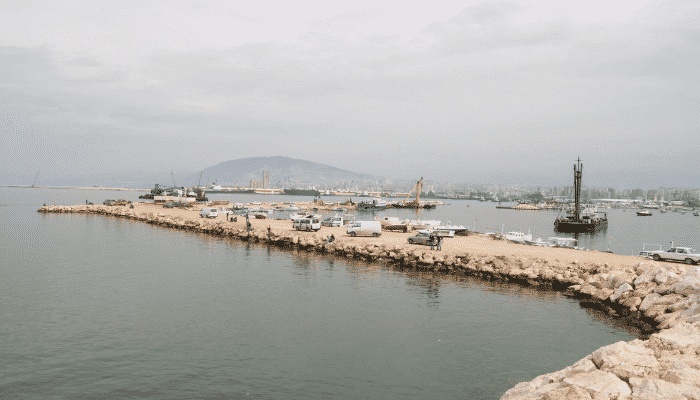
The port handles exports of oil, petrochemical goods and also general cargo. It is frequented by 300 ships every year and can accommodate vessels measuring more than 200 m with a maximum draft of 10 m, weighing around 250,000 DWT.
The port is divided into the western harbour and the eastern harbour. The former has a dry cargo handling berth spanning 150 m while the latter has a urea berth stretching 200 m. The cargo pier can accommodate ships weighing 50,000 DWT and is adjacent to the ro-ro handling facility. The port comprises 3 tanker terminals for handling oil, LNG and acids such as sulfuric acid. The oil berths can handle the world’s biggest oil carriers. Two separate berths on the western port area spanning 350 m, capable of accommodating ships weighing up to 50,000 DWT are utilised for handling shipments of ammonia, naphtha, and methanol.
Port of Misrata/ Qasr Ahmed
Also known as the Qar Ahmed port, it is one of the most crucial ports of Libya situated just 250 km from the capital Tripoli. Due to the port’s favourable geographical location and infrastructural development undertaken by the government, it is one of the busiest ports in Libya linked with major maritime trade routes of the world.
It is located in an industrial region housing manufacturing units, steelworks and a power station. The major cargoes handled at the port include grains, iron ore, livestock mainly sheep, containerised goods, petroleum products, oil, construction equipment, light machinery etc. In 2017, Misrata port received more than 700 cargo laden vessels carrying 105,600 TEU and 661,400 million tonnes of bulk and breakbulk.
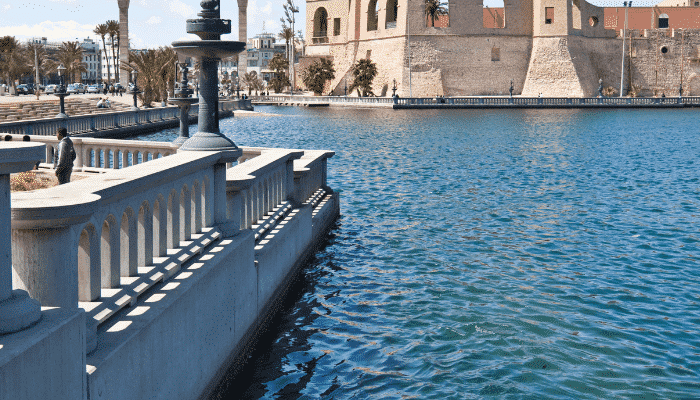
The port comprises 7 berths for handling containers with a total length of 1500 m, a draft of 11 m, two silo berths covering 400 m, and a ro-ro berth. It also has a free trade zone built in the late 1990s spanning 250 hectares. The port is undergoing expansion for constructing 8 berths with a length of 2000 m and a 12 m draft to enhance the port’s annual container handling capacity to five million.
Port equipment is in workable condition and includes 11 shore cranes, 3 gantries, 4 mobile cranes, 23 reach stackers and 40 forklifts. Misrata port also boasts gigantic storage space including open storage spanning more than 55 hectares, 10 warehouses covering 68,000 m2, 2-grain storage tanks with a 50,000 million tonne capacity and 550 reefer points. The port does not have a cold storage facility.
Port of Al Khoms/khums
The port of Al Khoms also known as Al khums is situated on the Libyan coastline east of the capital Tripoli. It is a medium-sized port dealing with bulk ships, containerised goods, livestock, automobiles apart from oil and chemicals. In 2017, the port was visited by 445 ships and handled 49,000 TEU and 80,000 bulk cargo. As per news reports, it is one of the few Libyan ports that has not suffered the disastrous consequences of civil war in terms of long term port blockages and destruction of equipment due to bombarding.
The port’s navigation channel has a depth of 15.5 m and an anchorage depth of 10 to 11 m. It comprises 20 berths; 5 for handling conventional cargo, 3 for containers and the rest are dedicated to oil, petroleum and chemicals. Each berth measures 100 to 450 m with drafts of 9 to 10 m respectively.
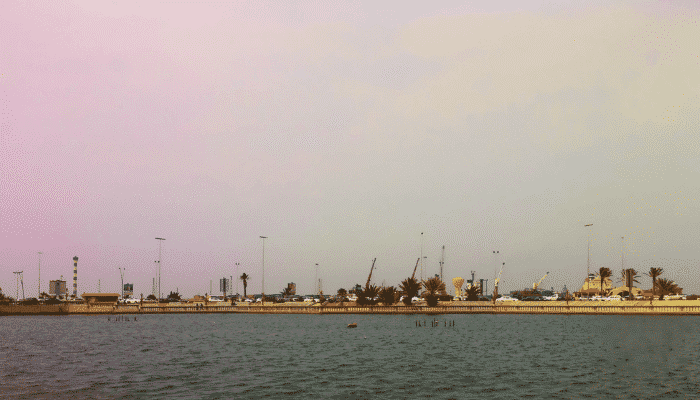
An organised facility, it also has 10 storage yards covering 15 hectares including a main storage area and a paved space for keeping bagged goods and containers. No closed storage space and warehouses are available at Al khums however it offers cold storage facility and 530 reefer stations. The port offers services such as bunkering, ship repair and maintenance for smaller vessels.
The nearby port area was once the capital of the Roman province in Africa and hence since the discovery of stunning roman ruins, it has become a famous tourist destination. Hence, the port authorities are planning to construct a wharf for passenger ships to boost local tourism.
You might also like to read:
- 8 Major Ports of Taiwan
- 2 Major Ports in Monaco
- 7 Major Ports in Qatar
- 5 Major Ports In Japan
- 6 Major Ports of North Korea
Disclaimer: The authors’ views expressed in this article do not necessarily reflect the views of Marine Insight. Data and charts, if used, in the article have been sourced from available information and have not been authenticated by any statutory authority. The author and Marine Insight do not claim it to be accurate nor accept any responsibility for the same. The views constitute only the opinions and do not constitute any guidelines or recommendation on any course of action to be followed by the reader.
The article or images cannot be reproduced, copied, shared or used in any form without the permission of the author and Marine Insight.
Do you have info to share with us ? Suggest a correction
Latest Maritime Knowledge Articles You Would Like:
Subscribe To Our Newsletters
By subscribing, you agree to our Privacy Policy and may receive occasional deal communications; you can unsubscribe anytime.



